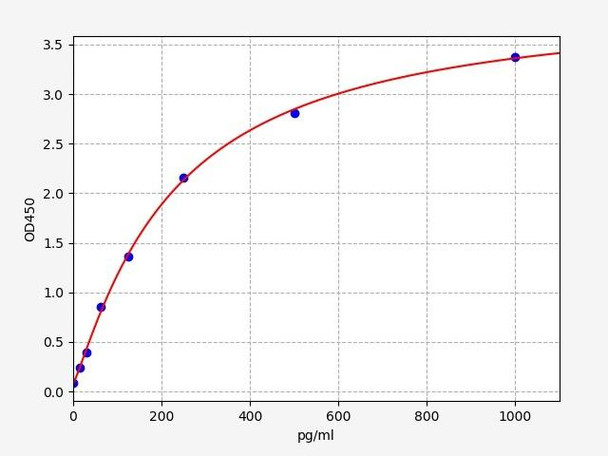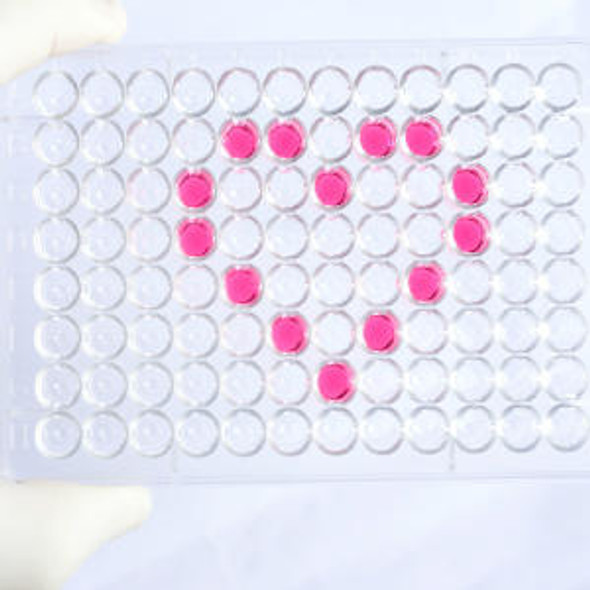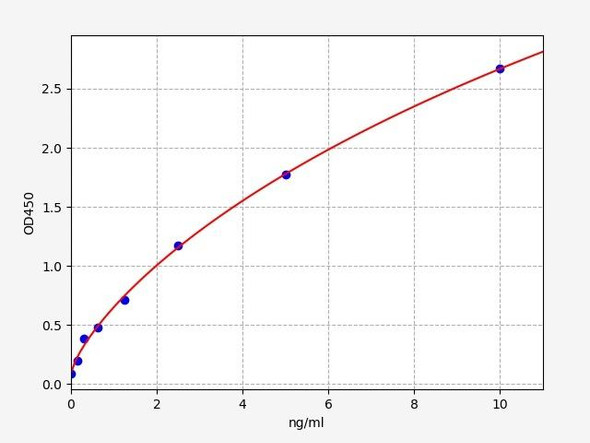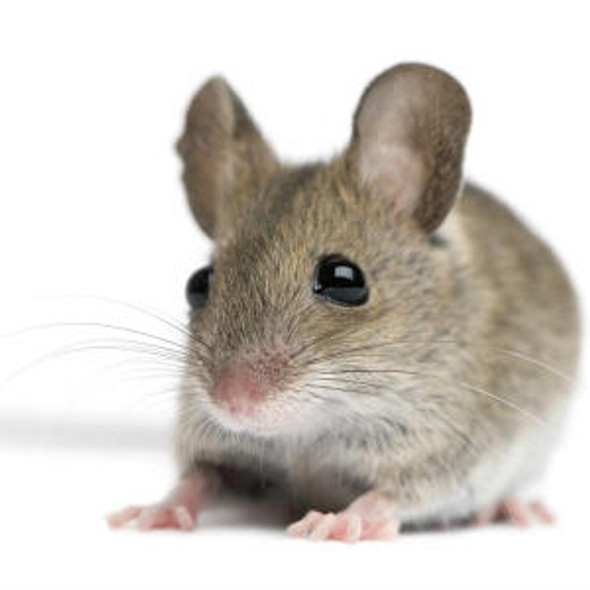Human TAB2 / TGF-beta Activated Kinase 1 / MAP3K7 Binding Protein 2 ELISA Kit
- SKU:
- HUFI01903
- Product Type:
- ELISA Kit
- Size:
- 96 Assays
- Uniprot:
- Q9NYJ8
- Sensitivity:
- 9.375pg/ml
- Range:
- 15.625-1000pg/ml
- ELISA Type:
- Sandwich
- Synonyms:
- TAB2, TGF-beta-activated kinase 1-binding protein 2, Mitogen-activated protein kinase kinase kinase 7-interacting protein 2, TAK1-binding protein 2, TAB-2
- Reactivity:
- Human
- Research Area:
- Cell Biology
Description
Human TAB2/TGF-beta Activated Kinase 1/MAP3K7 Binding Protein 2 ELISA Kit
The Human TAB2 (TGF Beta-Activated Kinase 1/MAP3K7 Binding Protein 2) ELISA Kit is specially designed for the precise measurement of TAB2 levels in human serum, plasma, and cell culture supernatants. This kit offers exceptional sensitivity and specificity, ensuring accurate and reproducible results for a variety of research applications.TAB2 is a critical protein that plays a key role in the TGF beta-activated kinase 1/MAP3K7 signaling pathway, regulating cellular responses to various stimuli.
Dysregulation of TAB2 has been linked to a variety of diseases, including cancer, inflammatory disorders, and autoimmune conditions. As a result, TAB2 serves as an important biomarker for investigating these diseases and developing potential therapeutic interventions.With its advanced technology and reliable performance, the Human TAB2 ELISA Kit is an invaluable tool for researchers studying the intricate mechanisms of TAB2 signaling and its implications in human health and disease.
| Product Name: | Human TAB2 / TGF-beta Activated Kinase 1 / MAP3K7 Binding Protein 2 ELISA Kit |
| Product Code: | HUFI01903 |
| Size: | 96 Assays |
| Alias: | TAB2, TGF-beta-activated kinase 1-binding protein 2, Mitogen-activated protein kinase kinase kinase 7-interacting protein 2, TAK1-binding protein 2, TAB-2 |
| Detection method: | Sandwich ELISA, Double Antibody |
| Application: | This immunoassay kit allows for the in vitro quantitative determination of Human TAB2 concentrations in serum plasma and other biological fluids. |
| Sensitivity: | 9.375pg/ml |
| Range: | 15.625-1000pg/ml |
| Storage: | 4°C for 6 months |
| Note: | For Research Use Only |
| Recovery: | Matrices listed below were spiked with certain level of Human TAB2 and the recovery rates were calculated by comparing the measured value to the expected amount of Human TAB2 in samples. | ||||||||||||||||
| |||||||||||||||||
| Linearity: | The linearity of the kit was assayed by testing samples spiked with appropriate concentration of Human TAB2 and their serial dilutions. The results were demonstrated by the percentage of calculated concentration to the expected. | ||||||||||||||||
| |||||||||||||||||
| CV(%): | Intra-Assay: CV<8% Inter-Assay: CV<10% |
| Component | Quantity | Storage |
| ELISA Microplate (Dismountable) | 8×12 strips | 4°C for 6 months |
| Lyophilized Standard | 2 | 4°C/-20°C |
| Sample/Standard Dilution Buffer | 20ml | 4°C |
| Biotin-labeled Antibody(Concentrated) | 120ul | 4°C (Protect from light) |
| Antibody Dilution Buffer | 10ml | 4°C |
| HRP-Streptavidin Conjugate(SABC) | 120ul | 4°C (Protect from light) |
| SABC Dilution Buffer | 10ml | 4°C |
| TMB Substrate | 10ml | 4°C (Protect from light) |
| Stop Solution | 10ml | 4°C |
| Wash Buffer(25X) | 30ml | 4°C |
| Plate Sealer | 5 | - |
Other materials and equipment required:
- Microplate reader with 450 nm wavelength filter
- Multichannel Pipette, Pipette, microcentrifuge tubes and disposable pipette tips
- Incubator
- Deionized or distilled water
- Absorbent paper
- Buffer resevoir
| Uniprot | Q9NYJ8 |
| UniProt Protein Function: | TAB2: Adapter linking MAP3K7/TAK1 and TRAF6. Promotes MAP3K7 activation in the IL1 signaling pathway. The binding of 'Lys-63'- linked polyubiquitin chains to TAB2 promotes autophosphorylation of MAP3K7 at 'Thr-187'. Involved in heart development. Interacts with MAP3K7 and TRAF6. Identified in the TRIKA2 complex composed of MAP3K7, TAB1 and TAB2. Binds 'Lys-63'-linked polyubiquitin chains. Interacts with NCOR1 and HDAC3 to form a ternary complex. Interacts (via C-terminal) with NUMBL (via PTB domain). Interacts (via the C-terminus) with WDR34 (via WD domains). Interacts with RBCK1. Widely expressed. In the embryo, expressed in the ventricular trabeculae, endothelial cells of the conotruncal cushions of the outflow tract and in the endothelial cells lining the developing aortic valves. 2 isoforms of the human protein are produced by alternative splicing. |
| UniProt Protein Details: | Protein type:Adaptor/scaffold Chromosomal Location of Human Ortholog: 6q25.1 Cellular Component: cytosol; endosome membrane; plasma membrane Molecular Function:protein binding Biological Process: activation of MAPK activity; activation of NF-kappaB transcription factor; heart development; I-kappaB kinase/NF-kappaB cascade; JNK cascade; MyD88-dependent toll-like receptor signaling pathway; negative regulation of autophagy; positive regulation of I-kappaB kinase/NF-kappaB cascade; positive regulation of protein kinase activity; stimulatory C-type lectin receptor signaling pathway; T cell receptor signaling pathway Disease: Congenital Heart Defects, Multiple Types, 2 |
| NCBI Summary: | The protein encoded by this gene is an activator of MAP3K7/TAK1, which is required for for the IL-1 induced activation of nuclear factor kappaB and MAPK8/JNK. This protein forms a kinase complex with TRAF6, MAP3K7 and TAB1, and it thus serves as an adaptor that links MAP3K7 and TRAF6. This protein, along with TAB1 and MAP3K7, also participates in the signal transduction induced by TNFSF11/RANKl through the activation of the receptor activator of NF-kappaB (TNFRSF11A/RANK), which may regulate the development and function of osteoclasts. Studies of the related mouse protein indicate that it functions to protect against liver damage caused by chemical stressors. Mutations in this gene cause congenital heart defects, multiple types, 2 (CHTD2). Alternative splicing results in multiple transcript variants. [provided by RefSeq, May 2014] |
| UniProt Code: | Q9NYJ8 |
| NCBI GenInfo Identifier: | 74753070 |
| NCBI Gene ID: | 23118 |
| NCBI Accession: | Q9NYJ8.1 |
| UniProt Secondary Accession: | Q9NYJ8,O94838, Q6I9W8, Q76N06, Q9UFP7, B2RCC4, E1P5A0 |
| UniProt Related Accession: | Q9NYJ8 |
| Molecular Weight: | 76kDa |
| NCBI Full Name: | TGF-beta-activated kinase 1 and MAP3K7-binding protein 2 |
| NCBI Synonym Full Names: | TGF-beta activated kinase 1/MAP3K7 binding protein 2 |
| NCBI Official Symbol: | TAB2 |
| NCBI Official Synonym Symbols: | CHTD2; TAB-2; MAP3K7IP2 |
| NCBI Protein Information: | TGF-beta-activated kinase 1 and MAP3K7-binding protein 2 |
| UniProt Protein Name: | TGF-beta-activated kinase 1 and MAP3K7-binding protein 2 |
| UniProt Synonym Protein Names: | Mitogen-activated protein kinase kinase kinase 7-interacting protein 2; TAK1-binding protein 2; TAB-2; TGF-beta-activated kinase 1-binding protein 2 |
| Protein Family: | TGF-beta-activated kinase 1 and MAP3K7-binding protein |
| UniProt Gene Name: | TAB2 |
*Note: Protocols are specific to each batch/lot. For the correct instructions please follow the protocol included in your kit.
Before adding to wells, equilibrate the SABC working solution and TMB substrate for at least 30 min at 37°C. When diluting samples and reagents, they must be mixed completely and evenly. It is recommended to plot a standard curve for each test.
| Step | Protocol |
| 1. | Set standard, test sample and control (zero) wells on the pre-coated plate respectively, and then, record their positions. It is recommended to measure each standard and sample in duplicate. Wash plate 2 times before adding standard, sample and control (zero) wells! |
| 2. | Aliquot 0.1ml standard solutions into the standard wells. |
| 3. | Add 0.1 ml of Sample / Standard dilution buffer into the control (zero) well. |
| 4. | Add 0.1 ml of properly diluted sample ( Human serum, plasma, tissue homogenates and other biological fluids.) into test sample wells. |
| 5. | Seal the plate with a cover and incubate at 37 °C for 90 min. |
| 6. | Remove the cover and discard the plate content, clap the plate on the absorbent filter papers or other absorbent material. Do NOT let the wells completely dry at any time. Wash plate X2. |
| 7. | Add 0.1 ml of Biotin- detection antibody working solution into the above wells (standard, test sample & zero wells). Add the solution at the bottom of each well without touching the side wall. |
| 8. | Seal the plate with a cover and incubate at 37°C for 60 min. |
| 9. | Remove the cover, and wash plate 3 times with Wash buffer. Let wash buffer rest in wells for 1 min between each wash. |
| 10. | Add 0.1 ml of SABC working solution into each well, cover the plate and incubate at 37°C for 30 min. |
| 11. | Remove the cover and wash plate 5 times with Wash buffer, and each time let the wash buffer stay in the wells for 1-2 min. |
| 12. | Add 90 µl of TMB substrate into each well, cover the plate and incubate at 37°C in dark within 10-20 min. (Note: This incubation time is for reference use only, the optimal time should be determined by end user.) And the shades of blue can be seen in the first 3-4 wells (with most concentrated standard solutions), the other wells show no obvious color. |
| 13. | Add 50 µl of Stop solution into each well and mix thoroughly. The color changes into yellow immediately. |
| 14. | Read the O.D. absorbance at 450 nm in a microplate reader immediately after adding the stop solution. |
When carrying out an ELISA assay it is important to prepare your samples in order to achieve the best possible results. Below we have a list of procedures for the preparation of samples for different sample types.
| Sample Type | Protocol |
| Serum | If using serum separator tubes, allow samples to clot for 30 minutes at room temperature. Centrifuge for 10 minutes at 1,000x g. Collect the serum fraction and assay promptly or aliquot and store the samples at -80°C. Avoid multiple freeze-thaw cycles. If serum separator tubes are not being used, allow samples to clot overnight at 2-8°C. Centrifuge for 10 minutes at 1,000x g. Remove serum and assay promptly or aliquot and store the samples at -80°C. Avoid multiple freeze-thaw cycles. |
| Plasma | Collect plasma using EDTA or heparin as an anticoagulant. Centrifuge samples at 4°C for 15 mins at 1000 × g within 30 mins of collection. Collect the plasma fraction and assay promptly or aliquot and store the samples at -80°C. Avoid multiple freeze-thaw cycles. Note: Over haemolysed samples are not suitable for use with this kit. |
| Urine & Cerebrospinal Fluid | Collect the urine (mid-stream) in a sterile container, centrifuge for 20 mins at 2000-3000 rpm. Remove supernatant and assay immediately. If any precipitation is detected, repeat the centrifugation step. A similar protocol can be used for cerebrospinal fluid. |
| Cell culture supernatant | Collect the cell culture media by pipette, followed by centrifugation at 4°C for 20 mins at 1500 rpm. Collect the clear supernatant and assay immediately. |
| Cell lysates | Solubilize cells in lysis buffer and allow to sit on ice for 30 minutes. Centrifuge tubes at 14,000 x g for 5 minutes to remove insoluble material. Aliquot the supernatant into a new tube and discard the remaining whole cell extract. Quantify total protein concentration using a total protein assay. Assay immediately or aliquot and store at ≤ -20 °C. |
| Tissue homogenates | The preparation of tissue homogenates will vary depending upon tissue type. Rinse tissue with 1X PBS to remove excess blood & homogenize in 20ml of 1X PBS (including protease inhibitors) and store overnight at ≤ -20°C. Two freeze-thaw cycles are required to break the cell membranes. To further disrupt the cell membranes you can sonicate the samples. Centrifuge homogenates for 5 mins at 5000xg. Remove the supernatant and assay immediately or aliquot and store at -20°C or -80°C. |
| Tissue lysates | Rinse tissue with PBS, cut into 1-2 mm pieces, and homogenize with a tissue homogenizer in PBS. Add an equal volume of RIPA buffer containing protease inhibitors and lyse tissues at room temperature for 30 minutes with gentle agitation. Centrifuge to remove debris. Quantify total protein concentration using a total protein assay. Assay immediately or aliquot and store at ≤ -20 °C. |
| Breast Milk | Collect milk samples and centrifuge at 10,000 x g for 60 min at 4°C. Aliquot the supernatant and assay. For long term use, store samples at -80°C. Minimize freeze/thaw cycles. |










